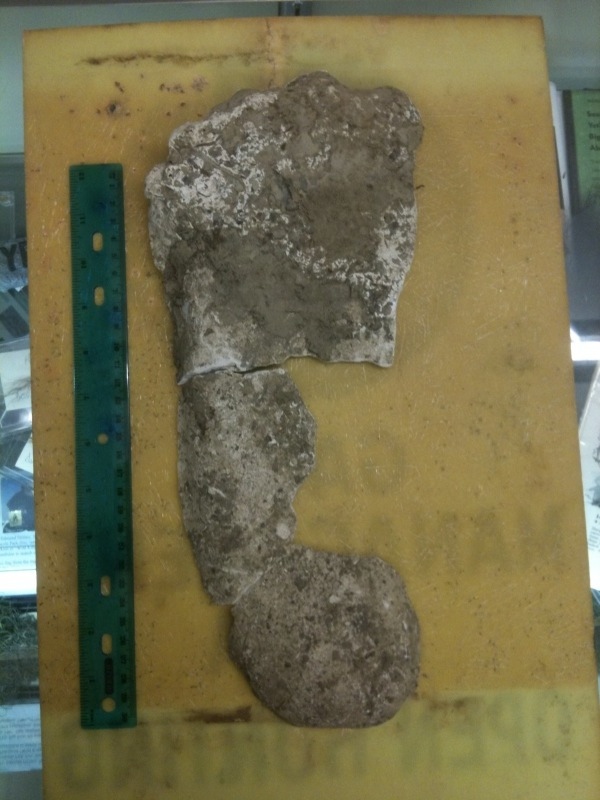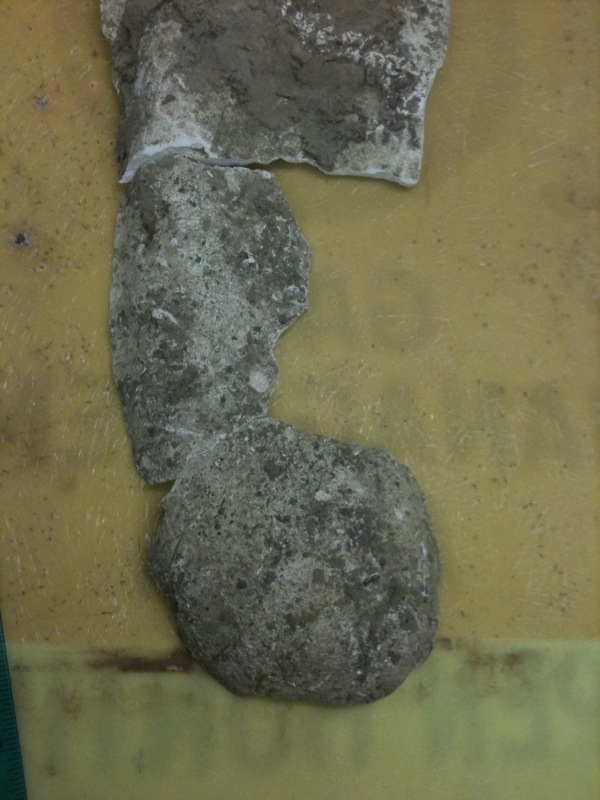New Maine “Bigfoot” Cast: Info Updated
Posted by: Loren Coleman on July 22nd, 2012
A Maine Bigfoot hunting group, lead by Mike Merchant, recovered the following 14″ long footcast made by what Merchant feels might have been a Bigfoot. It was cast in a rough, rural area near Burbank, north of Moosehead, Maine, two weeks ago, early in July 2012. Only one print was found due to the terrain not being conductive to other prints. No others were seen; if they would have seen others, tracking would have occurred. The cast broke because Merchant was low on casting materials.
Thanks to Bill Brock, also of the team, for sharing it with the International Cryptozoology Museum on July 21, 2012. Photos by Loren Coleman.
 Photos of the cast, with a closeup of the heel.
Photos of the cast, with a closeup of the heel.

About Loren Coleman
Loren Coleman is one of the world’s leading cryptozoologists, some say “the” leading living cryptozoologist. Certainly, he is acknowledged as the current living American researcher and writer who has most popularized cryptozoology in the late 20th and early 21st centuries.
Starting his fieldwork and investigations in 1960, after traveling and trekking extensively in pursuit of cryptozoological mysteries, Coleman began writing to share his experiences in 1969. An honorary member of Ivan T. Sanderson’s Society for the Investigation of the Unexplained in the 1970s, Coleman has been bestowed with similar honorary memberships of the North Idaho College Cryptozoology Club in 1983, and in subsequent years, that of the British Columbia Scientific Cryptozoology Club, CryptoSafari International, and other international organizations. He was also a Life Member and Benefactor of the International Society of Cryptozoology (now-defunct).
Loren Coleman’s daily blog, as a member of the Cryptomundo Team, served as an ongoing avenue of communication for the ever-growing body of cryptozoo news from 2005 through 2013. He returned as an infrequent contributor beginning Halloween week of 2015.
Coleman is the founder in 2003, and current director of the International Cryptozoology Museum in Portland, Maine.










team tazer 🙂
It’s unfortunate that it cracked. My obvious questions are:
1.) Were there others?
2.) If so, were additional prints cast?
3.) If there were more tracks, did Merchant (an experienced tracker) follow them?
This cast seems inordinately narrow for it’s length. Possibly a human track that was left when the the walker set their heel, then slipped forward, and continued on, leaving the toe section of the print? That or a Sasquatch with fashionably narrow feet.
The footprint being so narrow makes me wonder if it was a young teenage male or female Sasquatch because human young men and women can have thinner feet that widen over the years so perhaps this is a young Sasquatch print. The length alone make me think it’s not human unless the above comment about someone slipping in the dirt, but who would be barefoot out there in that terrain? I think that a young male or female Sasquatch may be the answer.
This is a good and unusual find, so well done guys!
there appears to be a pressure ridge along the exterior side, similar to what you’d expect from a human foot as well. Inconclusive at best.
Assuming that ruler is 12 inches, then this foot is like a Size 12 or 13 shoe. Totally within Human range. I know people with feet that big.
I have size 13 feet. My bare foot is just about 12 inches long. EEE as well. This is someone’s footprint with maybe a little slippage fore or aft or just a person with big feet. I know a guy in my sports league with size 15 shoes. He’s 6’6″. I don’t think this is a Bigfoot print…not wide enough. My heel print width is wider than this print.
BTW…having big feet is a real pain in the – well…foot.
The first report I read here located the print as taken from near Holden, Maine. The update locates the print from near Moosehead. There’s a huge distance between those areas. Can we get clarification?
The person sharing the cast miscommunicated the info at the museum; revised it later.
Bill Brock wasn’t there. Mike Merchant was.
The print seems to show an arched foot. I thought “real” bigfoot prints supposedly did not have arches, because their foot structure is different.
Well, I agree that the print looks human, but why would anyone be out in that area barefoot? That is why I’m open to the idea that it could be a young, like a preteen, or a teenage Sasquatch.
If this had been discovered almost anywhere else I would agree it is human, but out in the wilds where it was found?
mandors:
I think that the appearance of an arch may come from the inadequate quantity of casting material. I’m not sure it shows an arch at all. I mean you’re right; the evidence obtained thus far appears to support a foot structure that, although superficially similar to ours, is really much more like that of the known apes, just with considerably more hallucial convergence (unsurprising, given the ichnotaxonomy of fossil hominoids). That would mean: you see an arch, you might be thinking human.
The location might also raise Sweetsuisq’s question: what’s a barefoot human doing out there?
This is simply yet another example of what proponents need to keep doing: increasing the inventory of trackway evidence, to say nothing of the other forensic evidence that has so far tended to be rejected without review. You just keep going until the critical mass of open-minded scientists is reached and the concerted review finally happens.
Pardon Sweetsusiq for messing up your name. 🙂